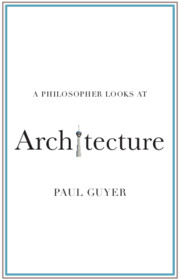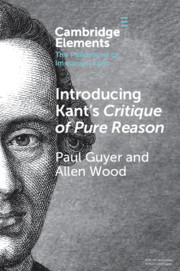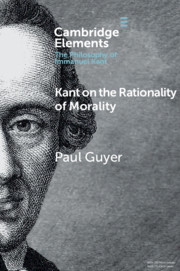372 results
Arthur Ripstein, Kant and the Law of War New York: Oxford University Press, 2021 Pp. xiii + 270 ISBN 978-0-10-760420-5 (hbk) $39.95
-
- Journal:
- Kantian Review / Volume 27 / Issue 2 / June 2022
- Published online by Cambridge University Press:
- 28 March 2022, pp. 334-337
- Print publication:
- June 2022
-
- Article
- Export citation
Kant’s Theory of Modern Art?
-
- Journal:
- Kantian Review / Volume 26 / Issue 4 / December 2021
- Published online by Cambridge University Press:
- 15 December 2021, pp. 619-634
- Print publication:
- December 2021
-
- Article
- Export citation
List of Figures
-
- Book:
- A Philosopher Looks at Architecture
- Published online:
- 20 May 2021
- Print publication:
- 20 May 2021, pp ix-x
-
- Chapter
- Export citation
Contents
-
- Book:
- A Philosopher Looks at Architecture
- Published online:
- 20 May 2021
- Print publication:
- 20 May 2021, pp vii-viii
-
- Chapter
- Export citation
1 - Good Construction, Functionality, and Aesthetic Appeal
-
- Book:
- A Philosopher Looks at Architecture
- Published online:
- 20 May 2021
- Print publication:
- 20 May 2021, pp 15-54
-
- Chapter
- Export citation
3 - Multiplicity of Meaning in Twentieth-Century Theories
-
- Book:
- A Philosopher Looks at Architecture
- Published online:
- 20 May 2021
- Print publication:
- 20 May 2021, pp 98-126
-
- Chapter
- Export citation
Notes
-
- Book:
- A Philosopher Looks at Architecture
- Published online:
- 20 May 2021
- Print publication:
- 20 May 2021, pp 181-202
-
- Chapter
- Export citation
4 - Words and Works
-
- Book:
- A Philosopher Looks at Architecture
- Published online:
- 20 May 2021
- Print publication:
- 20 May 2021, pp 127-162
-
- Chapter
- Export citation
Introduction
-
- Book:
- A Philosopher Looks at Architecture
- Published online:
- 20 May 2021
- Print publication:
- 20 May 2021, pp 1-14
-
- Chapter
- Export citation
2 - The Meaning of Beauty
-
- Book:
- A Philosopher Looks at Architecture
- Published online:
- 20 May 2021
- Print publication:
- 20 May 2021, pp 55-97
-
- Chapter
- Export citation
5 - Looking Forward
-
- Book:
- A Philosopher Looks at Architecture
- Published online:
- 20 May 2021
- Print publication:
- 20 May 2021, pp 163-180
-
- Chapter
- Export citation

A Philosopher Looks at Architecture
-
- Published online:
- 20 May 2021
- Print publication:
- 20 May 2021
Copyright page
-
- Book:
- A Philosopher Looks at Architecture
- Published online:
- 20 May 2021
- Print publication:
- 20 May 2021, pp vi-vi
-
- Chapter
- Export citation
Index
-
- Book:
- A Philosopher Looks at Architecture
- Published online:
- 20 May 2021
- Print publication:
- 20 May 2021, pp 203-208
-
- Chapter
- Export citation

Introducing Kant's Critique of Pure Reason
-
- Published online:
- 24 March 2021
- Print publication:
- 22 April 2021
-
- Element
- Export citation
1 - The Original Empty Formalism Objection
-
-
- Book:
- Practical Philosophy from Kant to Hegel
- Published online:
- 16 March 2021
- Print publication:
- 18 March 2021, pp 10-27
-
- Chapter
- Export citation
Neural connectivity biotypes: associations with internalizing problems throughout adolescence
-
- Journal:
- Psychological Medicine / Volume 51 / Issue 16 / December 2021
- Published online by Cambridge University Press:
- 29 May 2020, pp. 2835-2845
-
- Article
- Export citation
God and the Structure of the Transcendental Dialectic: On Willaschek’s Kant on the Sources of Metaphysics
-
- Journal:
- Kantian Review / Volume 25 / Issue 2 / June 2020
- Published online by Cambridge University Press:
- 30 April 2020, pp. 267-277
- Print publication:
- June 2020
-
- Article
- Export citation

Kant on the Rationality of Morality
-
- Published online:
- 01 July 2019
- Print publication:
- 11 July 2019
-
- Element
- Export citation
Luigi Caranti’s Kant’s Political Legacy
-
- Journal:
- Kantian Review / Volume 24 / Issue 2 / June 2019
- Published online by Cambridge University Press:
- 20 May 2019, pp. 275-288
- Print publication:
- June 2019
-
- Article
- Export citation

